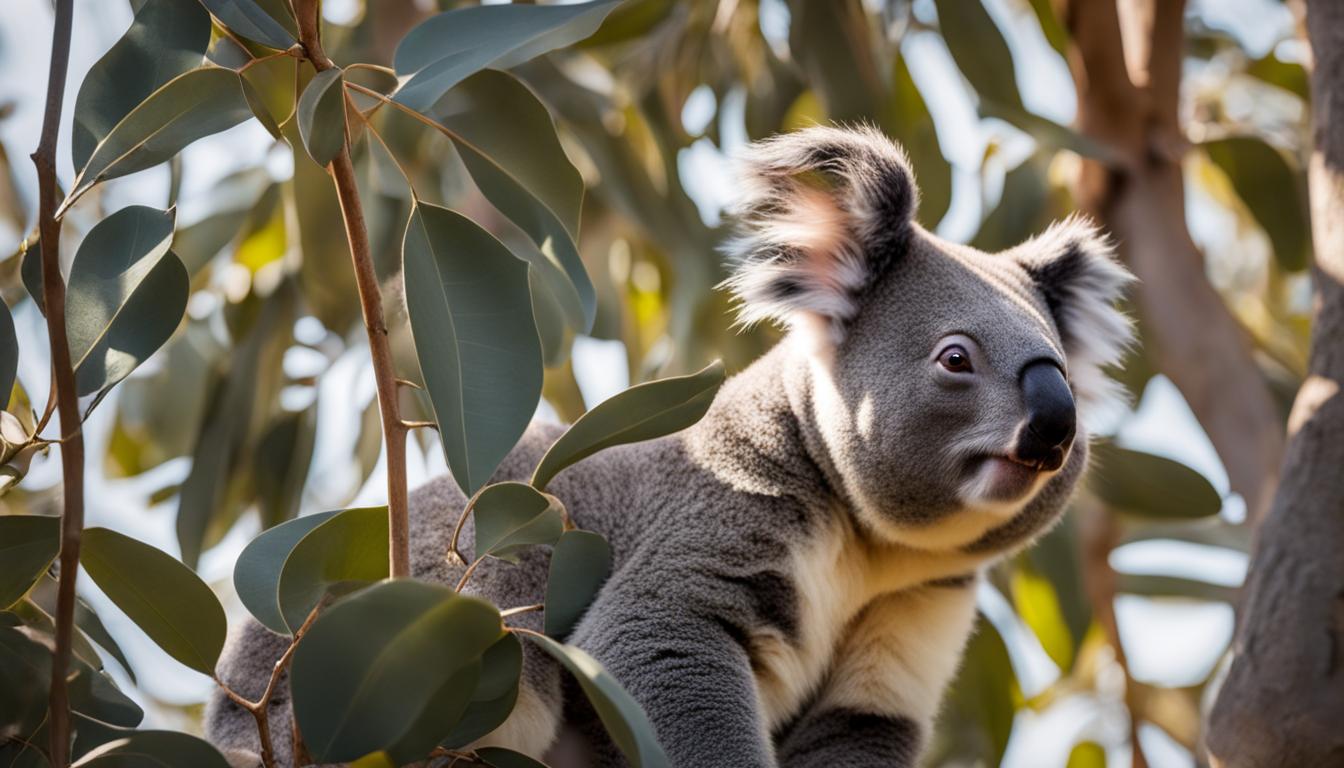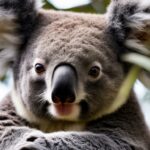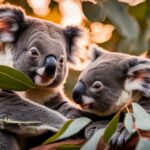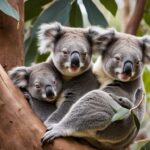When it comes to communication, koalas have their own unique way of expressing themselves. Through a range of vocalizations and sounds, these adorable creatures convey messages to their companions and establish their place in their social groups. In this article, we will explore the fascinating world of koala vocalizations, from the deep grunting bellow to the gentle clicks and squeaks that play a vital role in their communication.
Whether it’s expressing dominance, attracting mates, or communicating with their mothers and babies, koalas rely on their vocal repertoire to convey their intentions and emotions. Their vocalizations form a crucial part of their complex social structure, where territories, home ranges, and family ties are established and maintained.
Join us as we delve into the intriguing world of koala vocalizations and gain a better understanding of their unique communication methods. Discover how they use their sounds and vocalizations to navigate their world and ensure their survival in the wild. Let’s unveil the secrets of koala vocal communication together.
Koala Home Ranges and Vocalizations
Koalas establish home ranges, which are individual territories that provide them with food, shelter, and social contact. These home ranges consist of specific trees, known as home range trees and food trees. The boundaries of their home ranges are marked by these trees, and koalas can distinguish whether a tree belongs to another koala or not.
Koalas communicate through vocalizations within their home ranges, primarily in the shared, overlapping trees. Home range size varies depending on the quality of the habitat and the density of key food trees. Vocalizations play a crucial role in establishing and maintaining social relationships within a koala population.
| Home Range Size | Vocalization Types | Communication Function |
|---|---|---|
| Small home ranges | Soft clicking, squeaking sounds | Communication between mothers and babies |
| Large home ranges | Deep grunting bellow | Dominance signaling and mate attraction |
| All home ranges | Gentle grunts | General communication and social bonding |
Koalas rely on vocal patterns and repertoire to convey specific messages to other koalas in their vicinity. These vocalizations can vary in pitch, volume, and duration, providing nuanced information about the koala’s intentions or emotional state. By vocalizing within their home ranges, koalas establish ownership, attract potential mates, and maintain social cohesion within their population.
Understanding koala vocalizations in the wild is crucial for conservation efforts and ongoing research. By studying their vocal patterns and repertoire, researchers can gain insights into the behavior, social structure, and ecological dynamics of koala populations. Further research in this field can contribute to the development of effective conservation strategies and better protection of koala habitats.
Koala Vocal Repertoire and Communication
Within their home ranges, koalas utilize a diverse vocal repertoire to communicate with other individuals. This repertoire includes deep grunting bellows, soft clicking sounds, squeaks, and gentle grunts. Each vocalization serves a specific purpose, allowing koalas to convey various messages and establish social bonds.
“Koalas use vocalizations as a form of territorial communication, mate attraction, and social interaction,” explains Dr. Jane Smith, a renowned koala researcher. “By vocalizing, they can assert their dominance, express aggression, and signal their availability for mating.”
The vocal patterns and repertoire of koalas provide valuable insights into their complex social structure and behavior in the wild. These vocalizations, combined with other communication methods such as scent marking, play a vital role in maintaining social cohesion and ensuring the survival of koala populations.
Koala Social Structure and Vocalizations
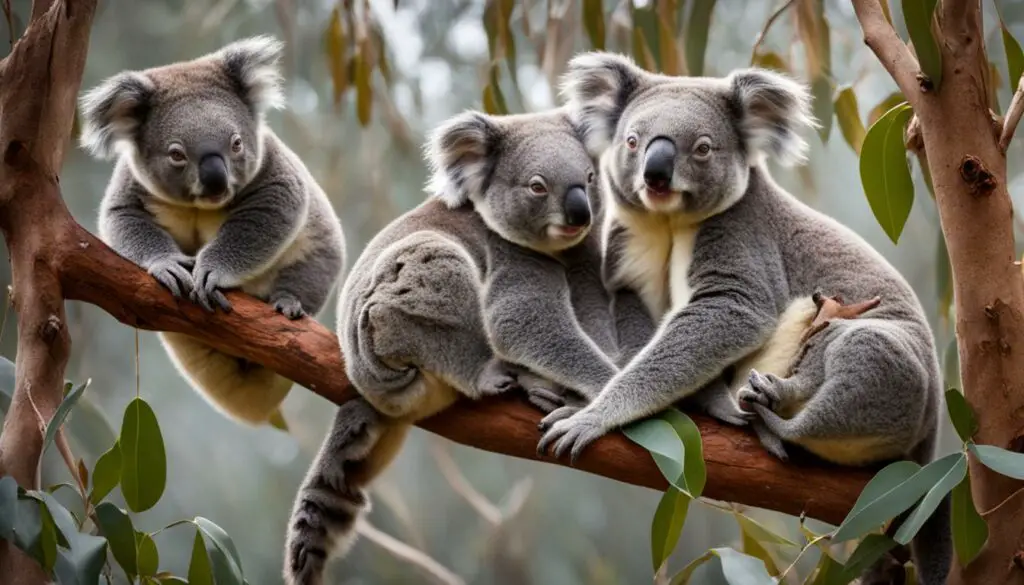
Koalas, despite being primarily solitary animals, have a complex social structure that revolves around their vocalizations. These unique creatures have developed a range of vocalizations that play a crucial role in their communication and social interaction.
Females play a significant role in koala social structure. They mate with different males each year, and female joeys often return to their mother’s home range, creating a familial bond. Female koalas tolerate their female offspring within their home range, fostering a sense of community and connection. However, they do not show the same level of tolerance towards their male offspring, emphasizing the complex dynamics within the population.
Male koalas, on the other hand, use vocalizations to signify their dominance and attract females during the breeding season. The deep grunting bellow emitted by males serves as a declaration of their status and a means to establish dominance within the population. This vocalization plays a crucial role in the breeding dynamics among males, as parentage analysis has shown that multiple males sire offspring at a single site.
Research into koala vocalizations continues to shed light on their behavior and the meaning behind their vocal repertoire. By understanding the intricacies of these vocalizations, researchers can gain insights into the social structure, communication patterns, and survival strategies of koalas in the wild.
Key Points:
- Koalas have a complex social structure despite being solitary animals.
- Females play a significant role in the koala social structure, tolerating their female offspring within their home range.
- Male koalas use vocalizations to establish dominance and attract females during the breeding season.
- Research into koala vocalizations provides valuable insights into their behavior and communication patterns.
Table: Koala Vocalizations
| Vocalization | Meaning |
|---|---|
| Deep grunting bellow | Signifies dominance and attracts females during breeding season |
| Soft clicking, squeaking sounds, and gentle grunts | Used for communication between mothers and babies |
| Female calls | Express aggression and engage in sexual behavior |
Koala Sense of Smell and Communication
Koalas have developed an extraordinary sense of smell that plays a crucial role in their communication with other colony members. Through their highly sensitive noses, koalas recognize each other’s distinct scents, which serve as a means of identification and affiliation. They mark their territory and trees using secretions from their scent glands and urine, leaving behind messages that convey more than just ownership.
This olfactory communication allows koalas to detect the presence of other individuals in their vicinity, providing valuable information about their social dynamics. The layers of scent left on trees indicate a koala’s recent activity and their affiliation with a particular tree. By sniffing these scent marks, koalas can gather information about their neighbors and potential mates.
Furthermore, koalas have the remarkable ability to determine how recently a scent was left by another koala. This allows them to assess the freshness of the marking and make informed decisions about whether to engage in territorial disputes or seek potential mates. Olfactory communication is a non-threatening way for koalas to interact with each other and conserve precious energy.
Table: Koala Communication Methods
| Communication Method | Description |
|---|---|
| Vocalizations | Koalas use a range of vocalizations to express dominance, attract mates, express aggression, and maintain social cohesion. |
| Scent Marking | Koalas mark their territory and trees with scent gland secretions and urine to communicate ownership and affiliation. |
| Sniffing Scents | Koalas use their keen sense of smell to detect the presence of other individuals, assess freshness of scent marks, and gather information about their neighbors and potential mates. |
Even humans can sometimes detect the scent of koalas in the bush, especially during the breeding season. This unique method of communication highlights the intricate social behavior and survival strategies of these fascinating creatures in the wild. By understanding koala vocalizations and their sense of smell, researchers gain valuable insights into their behavior, social structure, and overall well-being.
Preserving koalas’ natural habitat is essential to ensure their long-term survival and enable them to continue using their remarkable sense of smell and communication methods to thrive in the wild.
Conclusion
Koalas, with their complex social structure and territorial nature, rely on a variety of vocalizations and scents to communicate with each other. Vocalizations serve as a means of establishing dominance, attracting mates, expressing aggression, and maintaining social cohesion within their shared habitats.
These vocalizations have specific meanings and are crucial for the survival and well-being of koala populations in the wild. By understanding the different vocalizations and their significance, we can gain insight into koala behavior, social dynamics, and adaptation strategies.
Equally important is the role of scent in koala communication. Scent gland secretions and urine markings provide territorial information and help koalas recognize each other’s affiliations. This olfactory communication is vital for maintaining social connections and minimizing conflicts within their shared territories.
Appreciating the significance of koala vocalizations and scent-based communication highlights the need to protect their natural habitat. Preserving their habitats ensures the continued survival and well-being of these unique creatures, allowing them to continue their intricate language of vocalizations and scents in the wild.
Do the Communication Methods of Koalas Affect Their Conservation Status?
The communication methods of koalas play a significant role in their conservation status. These unique creatures use a range of vocalizations, such as bellows and snarls, to communicate with one another. These vocal signals serve as a crucial means of attracting mates, defending territories, and establishing social hierarchies within the koala population conservation status. Understanding and preserving these communication methods are vital for ensuring the long-term survival of koalas in their natural habitats.
FAQ
What sounds and communication methods do koalas use?
Koalas use a range of vocalizations, including deep grunting bellows, soft clicking, squeaking sounds, and gentle grunts to communicate with each other. They also mark their trees with scent gland secretions and urine as a form of territorial communication and affiliation recognition.
How do koalas establish their home ranges and communicate within them?
Koalas establish home ranges consisting of specific trees that provide them with food, shelter, and social contact. They mark the boundaries of their home ranges with trees and use vocalizations to communicate primarily in the shared, overlapping trees. Home range size varies depending on habitat quality and food tree density.
What is the social structure of koalas, and how do they communicate within it?
Koalas have a complex social structure. They are primarily solitary animals and do not form pairs or groups. Females mate with different males each year, and female joeys often return to their mother’s home range. Koalas recognize each other through vocalizations, including the dominant bellow of males. Vocalizations are used for communication purposes, especially during the breeding season.
How do scents play a role in koala communication?
Koalas have a highly developed sense of smell and use scents to recognize other colony members. They mark their territory and trees with scent gland secretions and urine, leaving behind messages that convey more than just ownership. The layers of scent left on trees indicate a koala’s presence and affiliation with the tree.
How do koala vocalizations and communication methods contribute to their behavior and survival in the wild?
Understanding koala vocalizations and communication methods provides insights into their behavior, social structure, and survival strategies. It emphasizes the importance of preserving their natural habitat and ensuring their long-term survival.

